#Plastics News
Explore tagged Tumblr posts
Text
"The substances behind the slimy strings from okra and the gel from fenugreek seeds could trap microplastics better than a commonly used synthetic polymer.
Texas researchers proposed in 2022 using these sticky natural polymers to clean up water. Now, they’ve found that okra and/or fenugreek extracts attracted and removed up to 90% of microplastics from ocean water, freshwater, and groundwater.
With funding from the U.S. Department of Energy, Rajani Srinivasan and colleagues at Tarleton State University found that the plant-based polymers from okra, fenugreek, and tamarind stick to microplastics, clumping together and sinking for easy separation from water.
In this next stage of the research, they have optimized the process for okra and fenugreek extracts and tested results in a variety of types of water.
To extract the sticky plant polymers, the team soaked sliced okra pods and blended fenugreek seeds in separate containers of water overnight. Then, researchers removed the dissolved extracts from each solution and dried them into powders.
Analyses published in the American Chemical Society journal showed that the powdered extracts contained polysaccharides, which are natural polymers. Initial tests in pure water spiked with microplastics showed that:
One gram of either powder in a quart (one liter) of water trapped microplastics the most effectively.
Dried okra and fenugreek extracts removed 67% and 93%, respectively, of the plastic in an hour.
A mixture of equal parts okra and fenugreek powder reached maximum removal efficiency (70%) within 30 minutes.
The natural polymers performed significantly better than the synthetic, commercially available polyacrylamide polymer used in wastewater treatment.
Then the researchers tested the plant extracts on real microplastic-polluted water. They collected samples from waterbodies around Texas and brought them to the lab. The plant extract removal efficiency changed depending on the original water source.
Okra worked best in ocean water (80%), fenugreek in groundwater (80-90%), and the 1:1 combination of okra and fenugreek in freshwater (77%).
The researchers hypothesize that the natural polymers had different efficiencies because each water sample had different types, sizes and shapes of microplastics.
Polyacrylamide, which is currently used to remove contaminants during wastewater treatment, has low toxicity, but its precursor acrylamide is considered toxic. Okra and fenugreek extracts could serve as biodegradable and nontoxic alternatives.
“Utilizing these plant-based extracts in water treatment will remove microplastics and other pollutants without introducing additional toxic substances to the treated water,” said Srinivasan in a media release, “thus reducing long-term health risks to the population.”
She had previously studied the use of food-grade plant extracts as non-toxic flocculants to remove textile-based pollutants from wastewater and thought, ‘Why not try microplastics?’"
-via Good News Network, May 10, 2025
#watere#water pollution#microplastics#plastic#plastic pollution#pollution#solarpunk#environment#okra#fenugreek#united states#north america#texas#environmental science#good news#hope
16K notes
·
View notes
Text
An overview of China's plastics industry

The plastics industry in China is a major player on the global market, characterized by its vast scale, technological prowess, and evolving sustainability initiatives. Due to its rich historical background and its current market size, China is undeniable in shaping the future of plastics manufacturing. This article delves into the multifaceted landscape of China's plastics industry, analyzing market trends, regulatory dynamics, environmental considerations, technological innovations, key players, international trade relations, and the challenges and opportunities that lie ahead. Through these diverse lenses, we gain valuable insights into China's plastics industry's current state and future trajectory.
1. Overview of China's Plastics Industry
Background Information
China's plastics industry has a rich history dating back to the early 1950s when the first plastic products were manufactured. From packaging to construction, China has played an important role in plastics production and innovation over the years.
Size and scope of the current market
With a market size exceeding billions of dollars, China has one of the largest plastics industries in the world today. Packaging materials, consumer goods, automotive parts, and more are all part of the sector, which caters to domestic and international markets.
2. Market Trends and Growth Opportunities
Preferences of emerging consumers
With shifting consumer preferences towards sustainable and eco-friendly products, the plastics industry in China is witnessing a growing demand for biodegradable and recyclable materials. By developing innovative solutions that reduce environmental impact, companies are adapting to meet these preferences.
Growth Driven by Technological Advances
The plastics industry in China is experiencing a revolution due to technological advances such as 3D printing, smart polymers, and nanotechnology. These innovations are enhancing product quality, efficiency, and sustainability, enabling manufacturers to explore new growth opportunities.
3. Environmental Impact and Sustainability Initiatives
Pollution caused by plastics
Plastic pollution and environmental degradation pose challenges to the China plastics industry, despite its economic importance. In response to the widespread use of single-use plastics, concerns have been raised about littering and marine pollution. Sustainable practices are being advocated.
Sustainability Initiatives by the Government
China has implemented a variety of initiatives to promote sustainability in the plastics industry in response to environmental concerns. Regulations on plastic waste management, recycling incentives, and support for research and development of eco-friendly materials are among them.
4. Developments in regulations and policies
Regulations impacting the industry recently
Regulatory changes in China have focused on reducing plastic waste and promoting a circular economy. Companies are required to meet stricter environmental standards and take responsibility for their products' lifecycles.
Plastic manufacturers face compliance challenges
Plastic manufacturers in China face challenges navigating the evolving regulatory landscape. Keeping competitiveness and meeting consumer expectations requires compliance with regulations, investing in sustainable practices, and adapting to changing policies.
5. Technological Innovations in Plastic Manufacturing
The development of biodegradable plastics
Traditional plastics are being eclipsed by biodegradable plastics. These innovative materials break down naturally, reducing environmental impact and giving Mother Nature a high five.
Production automation and Industry 4.0 in plastics
With automation and Industry 4.0, plastic manufacturing is changing. Smart factories, robots, and digital technologies are revolutionizing production processes, making plastic production more efficient and high-tech than ever before.
6. Analysis of key players and the market as a whole
Manufacturers of plastics in China
China's plastic industry is strong, with key players dominating the market like bosses. These manufacturers set trends that others can only dream about following.
Analysis of market share and competition
It's a plastic jungle out there, with fierce competition and shifting market dynamics. Market share analysis reveals who's leading the pack and who's still figuring things out.
7. Global Impact of International Trade Relations
Global Plastic Trade and China's Role
Plastics are made in China for the local market, but it's also a major player in the global plastic trade game. From exports to imports, China's influence ripples throughout international markets.
Industry-related trade agreements
As the plastic industry's hot drama plays out, trade agreements can make or break deals, impact prices, and dictate cross-border flows of goods. Keeping an eye on these deals is key to predicting trends.

8. Future Prospects and Challenges for China's Plastics Industry
Circular economy models offer opportunities
As the plastic industry works to reduce waste, innovate, and recycle, circular economy models are the sustainability superheroes we need. Get more info about CPRJ.
Sustainability Challenges
In the world of sustainability, there are challenges, from rethinking production processes to changing consumer mindsets. Switching to sustainable practices isn't all rainbows and butterflies. No one said it would be easy to save the planet!
In conclusion, the China plastics industry continues to navigate a complex terrain of innovation, regulation, and sustainability, shaping not only its own future but also influencing global trends in plastic manufacturing. It is a challenging and an exciting time for the industry as it adapts to changing dynamics and strives towards greater environmental responsibility. China's plastics industry can contribute to a resilient and responsible global plastic economy by staying attuned to market shifts, technological advancements, and regulatory developments.
0 notes
Text
China Plastics News: Your Gateway to Industry Insights
China Plastics News is a vital resource for staying updated on the latest developments in the plastics industry. Covering trends, innovations, and regulatory changes, it provides valuable insights into China's dynamic plastics market. From market analysis to technological advancements, this publication helps industry professionals navigate the complexities of the sector. Whether you're looking for news on new materials or updates on market conditions, China Plastics News delivers essential information to keep you informed and ahead.
Read more : https://www.adsalecprj.com/en/news/news_index.html
0 notes
Text
no but genuinely I lose a little more patience for people who won't wear wool, leather, silk, or fur every day that I live in a world where plastic is increasingly the only damn kind of clothing you can find (or the only kind of fabric for sewing, even)
obviously, animal cruelty is horrible. I believe that even industries that rely on the deaths of animals should make their lives as good and their ends as humane as possible. and many of these industries need tighter environmental regulations on their production practices- some of the chemicals involved are highly toxic and ill-controlled at times
but at some point, you have to wake up to the fact that the only alternative we've found to date is destroying our planet
it's all plastic. and plastic is horrible for the world- the environment, humans, and especially animals. how cruelty-free is it to cause mass habitat loss? or climate change that disrupts food sources for those animals on a vast scale? how is that better than the deaths of a relatively small proportion of animals comparatively?
(and don't even start with "but pineapple leather! but cactus leather!" when those are still basically plastic due to heavy plastics use in their production processes. there is currently no non-plastic alternative to most animal-based textile products)
I've always tried to keep in mind that we all have to decide where our line is, that we all consume and there's no way of living in this world that doesn't take something from it. that for me, plastic clothing is to be avoided as much as possible, and for others, animal clothing products are to be avoided as much as possible. that the choice is equally valid
but I'm having a hard time seeing it as valid anymore when it just feels like trying to push the unpleasant part away from yourself so you can pretend your choice has no negative impacts. you're not wearing animal skin (or wool that an animal didn't even die to produce), so surely your way of doing things is better! no animals were harmed in the making of your outfit!
except. they were.
they and all the rest of us.
#fuck plastic#except for medical purposes#textiles#capitalist hellscape#(because companies use 'going cruelty-free' as an excuse to make their entire lineup a cavalcade of plastic)#textile waste#plastic waste#'just wear cotton or linen or hemp!' I mean I do but also#I live in New England#good luck with that when winter comes around#just bought a wool mantle with a fur-trimmed collar (yes it's vintage fur) from a friend and I fully expect to get use out of it soon#I just want to be able to buy Real Clothing (ie Not Plastic)#I can for now but. how much longer will I be able to?
4K notes
·
View notes
Text
From the article:
The two students presented their groundbreaking project at the 2024 International Science and Engineering Fair (ISEF); a device that operates by using ultrasound waves to push microplastic particles to one side of a water flow, allowing clean water to pass through while trapping the contaminants. In their tests, the system successfully captured up to 94 per cent of microplastic particles, showing promise for real-world applications. "If we could refine this, maybe use more professional equipment, maybe go to a lab instead of testing from our home, we could really improve our device and get it ready for large-scale manufacturing," Justin told Business Insider. The duo envisioned their device being used in water treatment plants, directly modifying the quality of water for daily use. This application could significantly reduce the amount of microplastics that end up in water sources, protecting ecosystems and human health.
#microplastics#water filtration#plastics#plastic pollution#pollution#good news#environment#sustainability#hope#hopepunk#ecology#water conservation
2K notes
·
View notes
Text
Most people will tell you that giving your pets any kind of medication in pill form is an absolute nightmare, meanwhile I have the exact opposite problem.
A friend of mine was watching my cat Mim while I was travelling this weekend and when he went to split her weekly allergy pill (made to split into 4 small pills when you press down on it with a finger) to give her the usual 1/4, he fumbled it and sent it skittering across the floor where my ridiculous pill-loving menace of cat immediately gobbled down the whole thing, leading to me receiving a panicked phone call at 11 pm from said friend who was understandably freaking out (everyone’s fine, a single high dose won’t cause any problems as long as it’s just this once).
Behold: the villain herself, basking in the success of her crime (she’d be planning her next pill-related heist but, as you can see if you look closely, there’s there’s nothing but elevator music behind those eyes)
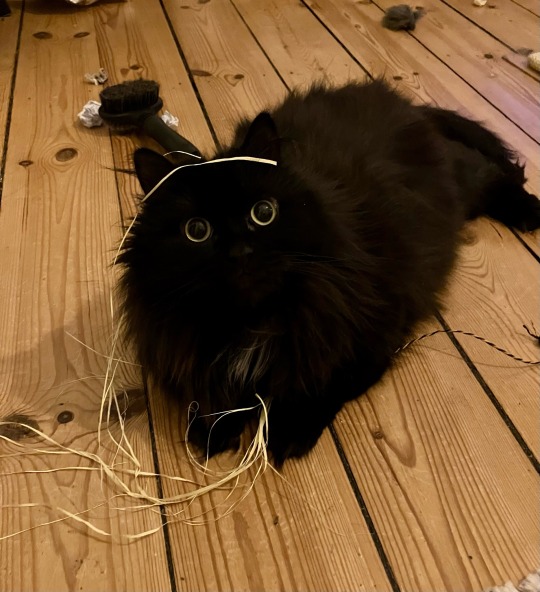
#cecil blogs her life#Mim the cat#cats of tumblr#black cats#we were just settling down for sleep when he called too and I was SO confused bc I’d prepared the pills beforehand so for a moment#I thought he might have grabbed the calming pills she gets for new years that she also gets 1/4 of so I was almost#freaking out right alongside of him but thankfully it was the allergy pills#he just hadn’t seen the little plastic thing I’d put out with them inside#it was actually both him and his gf cat sitting so they kept and extra close eye on her and spent even more time with her the rest of the#weekend - and Mim who’s a total attention hog just lapped it all up#pretty sure she thought it was a reward lmao
3K notes
·
View notes
Text
How to carry a baby; Kaiju edition:




Bonus:


I guess using a plastic bag wasn't a good idea
#godzilla#godzilla x kong: the new empire#godzilla minus one#kong#ultraman#ultraman rising#suko#ultraman rising emi#ken sato#how to carry babies#Ken and Kong being the best dads they are#godzilla failed#to carry Minus One I mean#but then again Minus isn't exactly cooperative#so understandable#plastic bags are cheap too ig#anyway MO is on the loose#I repeat MO is on the loose#good luck finding him before anything horrible happens Big G#do not repost#my art
1K notes
·
View notes
Text
i don't have an excuse for this. woe. young solas be upon ye.

#solas#dragon age#jpg#2 am is the traditional and valid time to post art#god i'm so rusty with painting. also my tablet needs a new screen cover#i don't like doing it myself bc i always get dust in there somehow#but the last time i went to a shop to get them to do it they did like.#an entire spanish inquisition style Interrogation on the spot. on my exact ethnicity down to the specific city of origin😭#like full on. what language do you speak... where are you from... where are your parents from... how long have you been here... etc#and THEN. had the AUDACITY. to ask me to leave a good google review.#i just want to put a plastic sheet onto my tablet and pay them a reasonable amount of money and then go home 😔#i think i have like the world's most easily profiled features bc this has happened to me on sight a double digit amount of times#and so far they're always correct about the general country so i answer out of reflex....#unfortunately i have a terminally polite demeanour and have never successfully gotten myself to say ''hey knock it off :)'' even once#anyway that is unrelated to the fanart. woe. young solas.
367 notes
·
View notes
Text
I just spent a good 3 or 4 minutes laughing bc I saw what appeared to be a Chadifying facetune of John Mulaney, but it turns out he just got a BUNCH OF WORK DONE on himself while I wasn't looking.


#borderline not even the same person#I said ''ew'' out loud and then laughed harder after hearing myself get grossed out#PLASTIC SURGERY JUMPSCARE#oh dude I can't look right at him. that is so fucking funny#sergle.txt#the guy went out and bought himself a new jawline. he also grew a mullet. but that's off topic
505 notes
·
View notes
Text

When self-described “ocean custodian” Boyan Slat took the stage at TED 2025 in Vancouver this week, he showed viewers a reality many of us are already heartbreakingly familiar with: There is a lot of trash in the ocean.
“If we allow current trends to continue, the amount of plastic that’s entering the ocean is actually set to double by 2060,” Slat said in his TED Talk, which will be published online at a later date.
Plus, once plastic is in the ocean, it accumulates in “giant circular currents” called gyres, which Slat said operate a lot like the drain of the bathtub, meaning that plastic can enter these currents but cannot leave.
That’s how we get enormous build-ups like the Great Pacific Garbage Patch, a giant collection of plastic pollution in the ocean that is roughly twice the size of Texas.
As the founder and CEO of The Ocean Cleanup, Slat’s goal is to return our oceans to their original, clean state before 2040. To accomplish this, two things must be done.
First: Stop more plastic from entering the ocean. Second: Clean up the “legacy” pollution that is already out there and doesn’t go away by itself.
And Slat is well on his way.
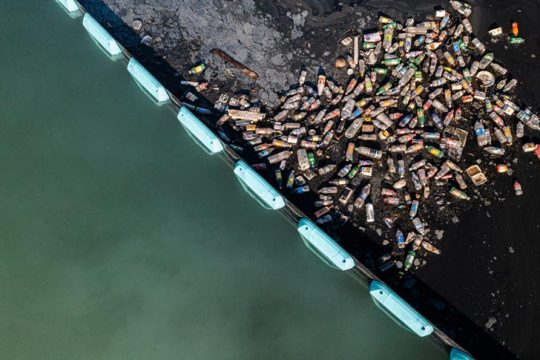
Pictured: Kingston Harbour in Jamaica. Photo courtesy of The Ocean Cleanup Project
When Slat’s first TEDx Talk went viral in 2012, he was able to organize research teams to create the first-ever map of the Great Pacific Garbage Patch. From there, they created a technology to collect plastic from the most garbage-heavy areas in the ocean.
“We imagined a very long, u-shaped barrier … that would be pushed by wind and waves,” Slat explained in his Talk.
This barrier would act as a funnel to collect garbage and be emptied out for recycling.
But there was a problem.
“We took it out in the ocean, and deployed it, and it didn’t collect plastic,” Slat said, “which is a pretty important requirement for an ocean cleanup system.”
Soon after, this first system broke into two. But a few days later, his team was already back to the drawing board.
From here, they added vessels that would tow the system forward, allowing it to sweep a larger area and move more methodically through the water. Mesh attached to the barrier would gather plastic and guide it to a retention area, where it would be extracted and loaded onto a ship for sorting, processing, and recycling.
It worked.
“For 60 years, humanity had been putting plastic into the ocean, but from that day onwards, we were also taking it back out again,” Slat said, with a video of the technology in action playing on screen behind him.
To applause, he said: “It’s the most beautiful thing I’ve ever seen, honestly.”
Over the years, Ocean Cleanup has scaled up this cleanup barrier, now measuring almost 2.5 kilometers — or about 1.5 miles — in length. And it cleans up an area of the ocean the size of a football field every five seconds.

Pictured: The Ocean Cleanup's System 002 deployed in the Great Pacific Garbage Patch. Photo courtesy of The Ocean Cleanup
The system is designed to be safe for marine life, and once plastic is brought to land, it is recycled into new products, like sunglasses, accessories for electric vehicles, and even Coldplay’s latest vinyl record, according to Slat.
These products fund the continuation of the cleanup. The next step of the project is to use drones to target areas of the ocean that have the highest plastic concentration.
In September 2024, Ocean Cleanup predicted the Patch would be cleaned up within 10 years.
However, on April 8, Slat estimated “that this fleet of systems can clean up the Great Pacific Garbage Patch in as little as five years’ time.”
With ongoing support from MCS, a Netherlands-based Nokia company, Ocean Cleanup can quickly scale its reliable, real-time data and video communication to best target the problem.
It’s the largest ocean cleanup in history.
But what about the plastic pollution coming into the ocean through rivers across the world? Ocean Cleanup is working on that, too.
To study plastic pollution in other waterways, Ocean Cleanup attached AI cameras to bridges, measuring the flow of trash in dozens of rivers around the world, creating the first global model to predict where plastic is entering oceans.
“We discovered: Just 1% of the world’s rivers are responsible for about 80% of the plastic entering our oceans,” Slat said.
His team found that coastal cities in middle-income countries were primarily responsible, as people living in these areas have enough wealth to buy things packaged in plastic, but governments can’t afford robust waste management infrastructure.
Ocean Cleanup now tackles those 1% of rivers to capture the plastic before it reaches oceans.

Pictured: Interceptor 007 in Los Angeles. Photo courtesy of The Ocean Cleanup
“It’s not a replacement for the slow but important work that’s being done to fix a broken system upstream,” Slat said. “But we believe that tackling this 1% of rivers provides us with the only way to rapidly close the gap.”
To clean up plastic waste in rivers, Ocean Cleanup has implemented technology called “interceptors,” which include solar-powered trash collectors and mobile systems in eight countries worldwide.
In Guatemala, an interceptor captured 1.4 million kilograms (or over 3 million pounds) of trash in under two hours. Now, this kind of collection happens up to three times a week.
“All of that would have ended up in the sea,” Slat said.
Now, interceptors are being brought to 30 cities around the world, targeting waterways that bring the most trash into our oceans. GPS trackers also mimic the flow of the plastic to help strategically deploy the systems for the most impact.
“We can already stop up to one-third of all the plastic entering our oceans once these are deployed,” Slat said.
And as soon as he finished his Talk on the TED stage, Slat was told that TED’s Audacious Project would be funding the deployment of Ocean Cleanup’s efforts in those 30 cities as part of the organization’s next cohort of grantees.
While it is unclear how much support Ocean Cleanup will receive from the Audacious Project, Head of TED Chris Anderson told Slat: “We’re inspired. We’re determined in this community to raise the money you need to make that 30-city project happen.”
And Slat himself is determined to clean the oceans for good.
“For humanity to thrive, we need to be optimistic about the future,” Slat said, closing out his Talk.
“Once the oceans are clean again, it can be this example of how, through hard work and ingenuity, we can solve the big problems of our time.”
-via GoodGoodGood, April 9, 2025
#ocean#oceans#plastic#plastic pollution#ocean cleanup#ted talks#boyan slat#climate action#climate hope#hopepunk#pollution#environmental issues#environment#pacific ocean#rivers#marine life#good news#hope
9K notes
·
View notes
Text
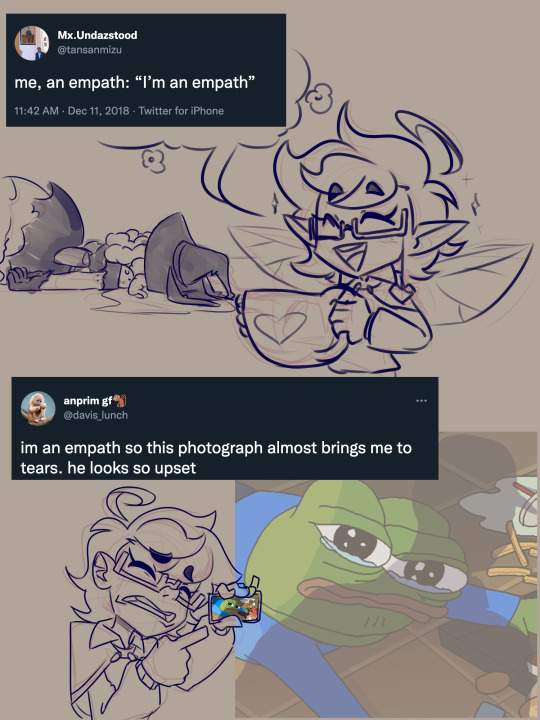
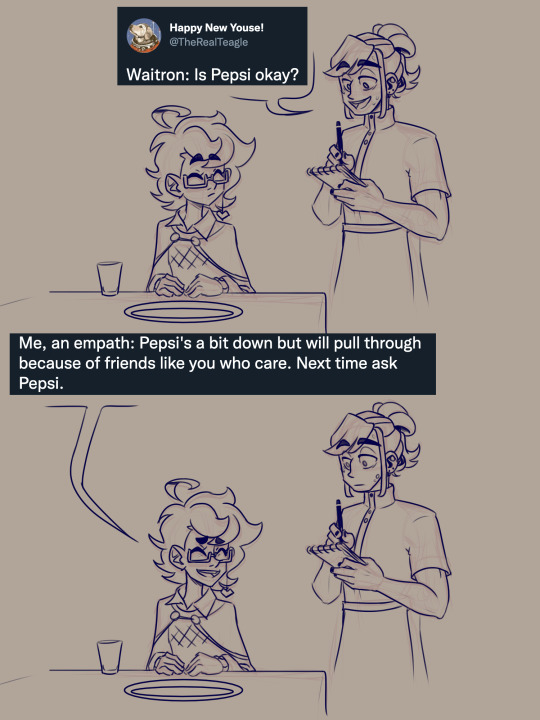
Empath Naven memes because it's been six whole months since I read Prison of Plastic and I still hadn't drawn him.
Bonus:

#babs does at#epithet erased#prison of plastic#local billionaire “allegedly” “not guilty” of any “crimes”#<- okay this is my new naven tag now. it's really funny#naven nuknuk#lorelai blyndeff#(briefly)#it's pretty unlikely that any of the Bois have jobs but waiter Dark Star is a headcanon I have for no reason other than he seems the type#and with his epithet he could get double the tips#edit: jesus christ it's been literal years and the tumblr app still can't put images below post breaks. god.#epithet fanart
262 notes
·
View notes
Note
Headcanon for the last man to die au: Odysseus hates the feeling of synthetic fibers. ie polyester, acrylic, ect.
i can definitely see that
he actually prefers a lot of older things throughout time and takes a while to really get adjusted to "newer" things, but that doesn't mean he doesn't want to learn about all these new things either
for example: once cars came around he probably became bored and took one apart and tried to put it back together- but he'd never drive a car, things like that
#invention of plastic was crazy for him#not as much as electricity was but yknow#he's actually very open to learning about new things but that doesn't mean he'll use them at first if ever#exactly like the internet#OOC. / answered.#ODYSSEUS. / posts.#the final man to die au#timelessorchid
151 notes
·
View notes
Text
"The substances behind the slimy strings from okra and the gel from fenugreek seeds could trap microplastics better than a commonly used synthetic polymer.
Texas researchers proposed in 2022 using these sticky natural polymers to clean up water. Now, they’ve found that okra and/or fenugreek extracts attracted and removed up to 90% of microplastics from ocean water, freshwater, and groundwater.
With funding from the U.S. Department of Energy, Rajani Srinivasan and colleagues at Tarleton State University found that the plant-based polymers from okra, fenugreek, and tamarind stick to microplastics, clumping together and sinking for easy separation from water.
In this next stage of the research, they have optimized the process for okra and fenugreek extracts and tested results in a variety of types of water.
To extract the sticky plant polymers, the team soaked sliced okra pods and blended fenugreek seeds in separate containers of water overnight. Then, researchers removed the dissolved extracts from each solution and dried them into powders.
Analyses published in the American Chemical Society journal showed that the powdered extracts contained polysaccharides, which are natural polymers. Initial tests in pure water spiked with microplastics showed that:
One gram of either powder in a quart (one liter) of water trapped microplastics the most effectively.
Dried okra and fenugreek extracts removed 67% and 93%, respectively, of the plastic in an hour.
A mixture of equal parts okra and fenugreek powder reached maximum removal efficiency (70%) within 30 minutes.
The natural polymers performed significantly better than the synthetic, commercially available polyacrylamide polymer used in wastewater treatment.
Then the researchers tested the plant extracts on real microplastic-polluted water. They collected samples from waterbodies around Texas and brought them to the lab. The plant extract removal efficiency changed depending on the original water source.
Okra worked best in ocean water (80%), fenugreek in groundwater (80-90%), and the 1:1 combination of okra and fenugreek in freshwater (77%).
The researchers hypothesize that the natural polymers had different efficiencies because each water sample had different types, sizes and shapes of microplastics.
Polyacrylamide, which is currently used to remove contaminants during wastewater treatment, has low toxicity, but its precursor acrylamide is considered toxic. Okra and fenugreek extracts could serve as biodegradable and nontoxic alternatives.
“Utilizing these plant-based extracts in water treatment will remove microplastics and other pollutants without introducing additional toxic substances to the treated water,” said Srinivasan in a media release, “thus reducing long-term health risks to the population.”
She had previously studied the use of food-grade plant extracts as non-toxic flocculants to remove textile-based pollutants from wastewater and thought, ‘Why not try microplastics?’"
-via Good News Network, May 10, 2025
#microplastics#plastic#plastic pollution#okra#fenugreek#biotechnology#solarpunk#water pollution#pollution#united states#north america#texas#good news#hope
210 notes
·
View notes
Text
From the article:
Researchers led by Takuzo Aida at the RIKEN Center for Emergent Matter Science (CEMS) have developed a durable plastic that won’t contribute to microplastic pollution in our oceans. The new material is as strong as conventional plastics and biodegradable, but what makes it special is that it breaks down in seawater. The new plastic is therefore expected to help reduce harmful microplastic pollution that accumulates in oceans and soil and eventually enters the food chain.
#biodegradable plastic#plastic#microplastic#microplastic pollution#plastic pollution#ocean pollution#ocean conservation#good news#hope#hopepunk#habitat#environment#ecology
1K notes
·
View notes
Text









epithet sketchdump with some ocs sprinkled in there
#ee tag kinda dead lately so. repostin some older stuff#+ a few new things. as a treat#prison of plastic spoilers#epithet erased#epithet erased oc#bean shaped baby naven makes me laugh every time i look at him. baby!#naven nuknuk#yoomtah#yoomclaw as well#lorelai blyndeff#rick shades#phoenica fleecity#gio but just his hand#doodles#ocs ->#allory vokabue#she is supposedly screaming at yoom here. dont worry about it#taina cherami#tainas eyes are supposed to look like oreos!#they aren’t a result of any epithet. they’re genetic- sorta like martins button eyes#larry vokabue#still figuring out his hair#honestly i aughta just give larry like. long dreads or something. no more ponytail.. all my ee ocs have ponytails
179 notes
·
View notes
Text
Dandelion News - April 8-14
Based on preliminary results of this poll, for the next few weeks I’m gonna test out doing 5 articles a week instead of 10, as part of an effort to maintain my own mental health. If these half-sized posts get markedly fewer notes, I’ll try to figure out a different compromise.
Like these weekly compilations? Tip me at $kaybarr1735 or check out my Dandelion Doodles!
1. Zookeepers prepare Easter treats for animals

“”Our Asiatic lion cubs, who have just turned one, are at a crucial stage in their development, honing their natural exploratory and hunting instincts. Enrichment — like the enormous, scented Easter egg — plays an important role in this, helping to diversify their habitat and encouraging them to fully engage their strength and remarkably keen sense of smell.””
2. ‘People love being here’: London development shows harmony between nature and housing

“[… T]he charmingly named Tadpole Garden Village in Wiltshire will have 28 hectares (68 acres) of green space and nearly 2,000 homes. […] “We were initially brought in to find a nature-based solution to the flooding of the River Quaggy. We linked it to a floodplain and created sustainable urban drainage systems[….]””
3. Federal judge restores AP’s full access to White House events in victory for press freedom

“The ruling affirms that the First Amendment prohibits punishing journalists for refusing to adopt government-mandated language[….] “"Today’s ruling affirms the fundamental right of the press and public to speak freely without government retaliation.””
4. Huge Reductions in Plastic Pollution Along Aussie Coastlines
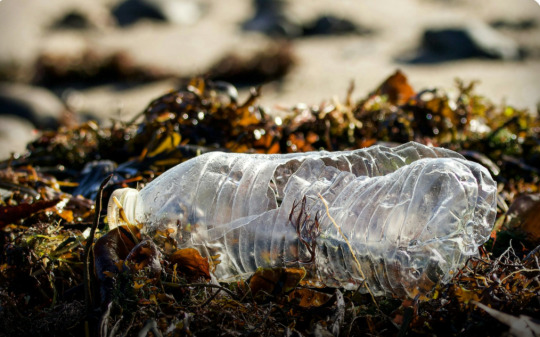
“[… P]lastic pollution along Australian coastlines has decreased by more than a third (39 per cent) over the past ten years[…. Other research found] a 16 percent increase in areas where no plastic debris was found at all.”
5. Pangolarium: world's first pangolin rehab facility opens in South Africa
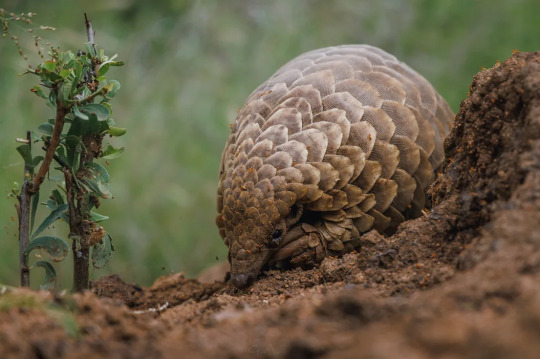
“A purpose-built facility like the Pangolarium will give rescued pangolins the best chance at regaining health. Monitored release back into the wild is the goal whenever possible[….] “It will also be a research and conservation hub for pangolin academics, rehabilitators and veterinarians to share information and knowledge[….]””
April 1-7 news here | (all credit for images and written material can be found at the source linked; I don’t claim credit for anything but curating.)
#hopepunk#good news#nature#animals#lion#lion cub#london zoo#zoo#london#uk#housing#green space#green infrastructure#us politics#associated press#freedom of the press#trump administration#first amendment#australia#plastic#pollution#littering#south africa#pangolin#wildlife rehabilitation#wildlife rescue#conservation
156 notes
·
View notes